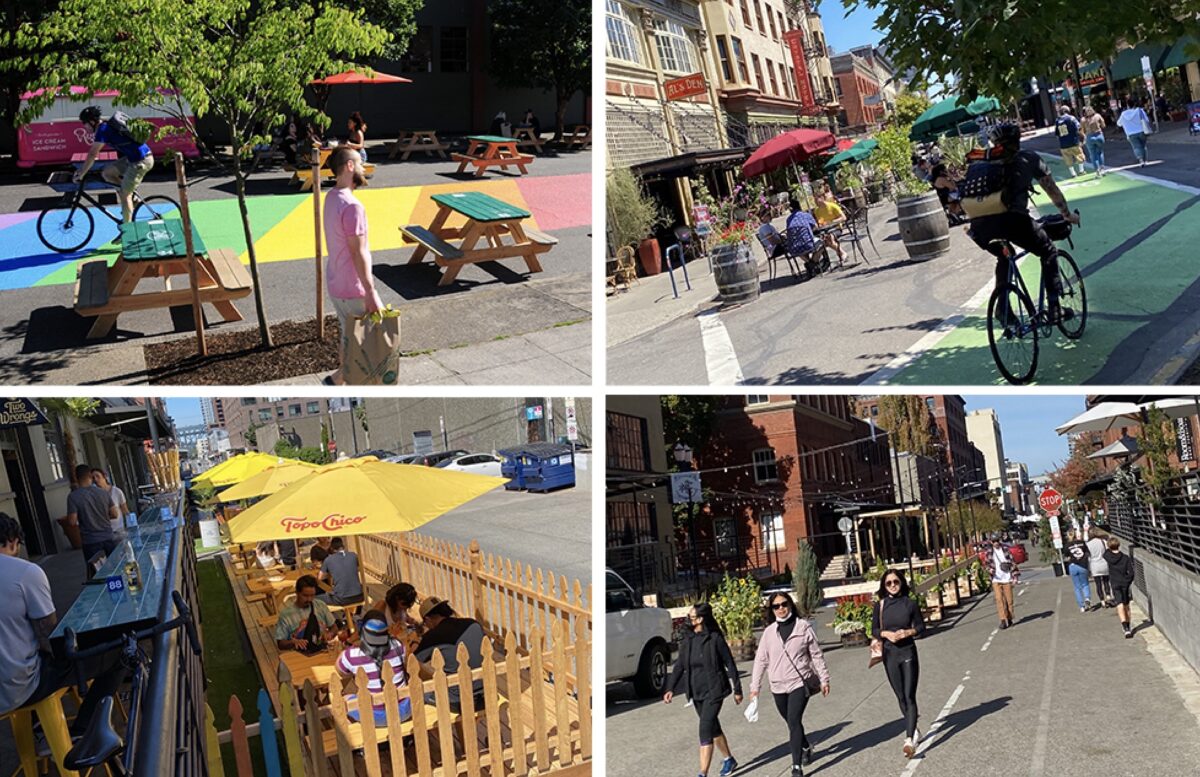
(Photos: Jonathan Maus/BikePortland)
“We’re really excited to be able to turn this into something a little more intentional and real.”
— Nick Falbo, PBOT
The proliferation of plazas and parklets in Portland since the onset of the pandemic has been nothing short of a revolution. Pre-Covid, the mere suggestion of using a few parking spots — much less an entire block — for anything other than parking cars would have been enough to spark vehement opposition. But once business owners realized they could make more money using the street to park paying customers rather than private cars, they quickly lost interest in parking advocacy.
Now with the Portland Bureau of Transportation (PBOT) committed to an expansion of the program, there appears to be no going back. What began as a temporary, stopgap measure to keep businesses afloat at the height of Covid restrictions, has quickly morphed into something much more significant that is likely to forever change our relationship with streets.
Speaking at two PBOT advisory committee meetings last month, planner Nick Falbo shared an outline of a new, federally-funded city program named Vibrant and Inclusive Community Spaces, that will institutionalize business plazas and parklets. PBOT has secured $2.5 million in federal American Rescue Plan funds to establish the program.
“Everything… we’ve done [so far] has been done kind of in a real scrappy fashion with bits and pieces over here and people working on the side. We’re really excited to be able to turn this into something a little more intentional and real in the years moving forward,” Falbo told members of the PBOT Bureau Budget Advisory Committee on October 21st.



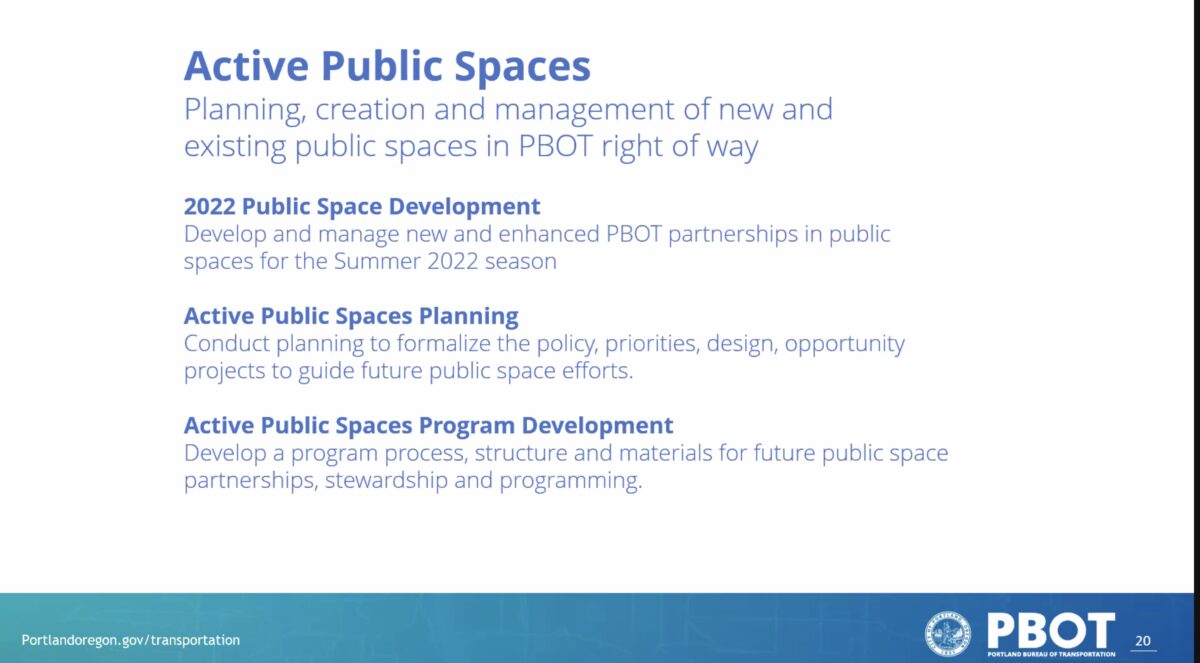
A slide (above) shared by Falbo at the BBAC shows the agency sees these plazas as much more than places to grab drinks and dinner:
“This project and its sub-programs aim to boost business and community prosperity through reduced costs to businesses, increasing community confidence in outdoor public spaces, encouraging community participation, improving the built environment of neighborhoods, and providing places to gather and reconnect people.”
Driving this bureaucratic inertia is a simple fact: Despite their dramatic impact on our public spaces, these plazas are extremely popular and have produced almost zero controversy.
When Covid hit, PBOT rolled out the red carpet for businesses to operate in the street and handed out free permits to use public right-of-way at an unprecedented clip. Before the onset of Covid in spring 2020, PBOT had permitted just two street plazas and 10 parklets (a.k.a. parking plazas). This summer alone they handed out 88 street plaza permits (of which about 40 are active) and 401 parking plaza permits. Falbo estimates there are over 500 street dining patios currently in operation citywide.
That’s a lot of curbside space formerly used to park cars. In just one year, we’ve made more progress shifting the public perception of streets as being solely the domain of cars then we’ve made in decades of prior advocacy.
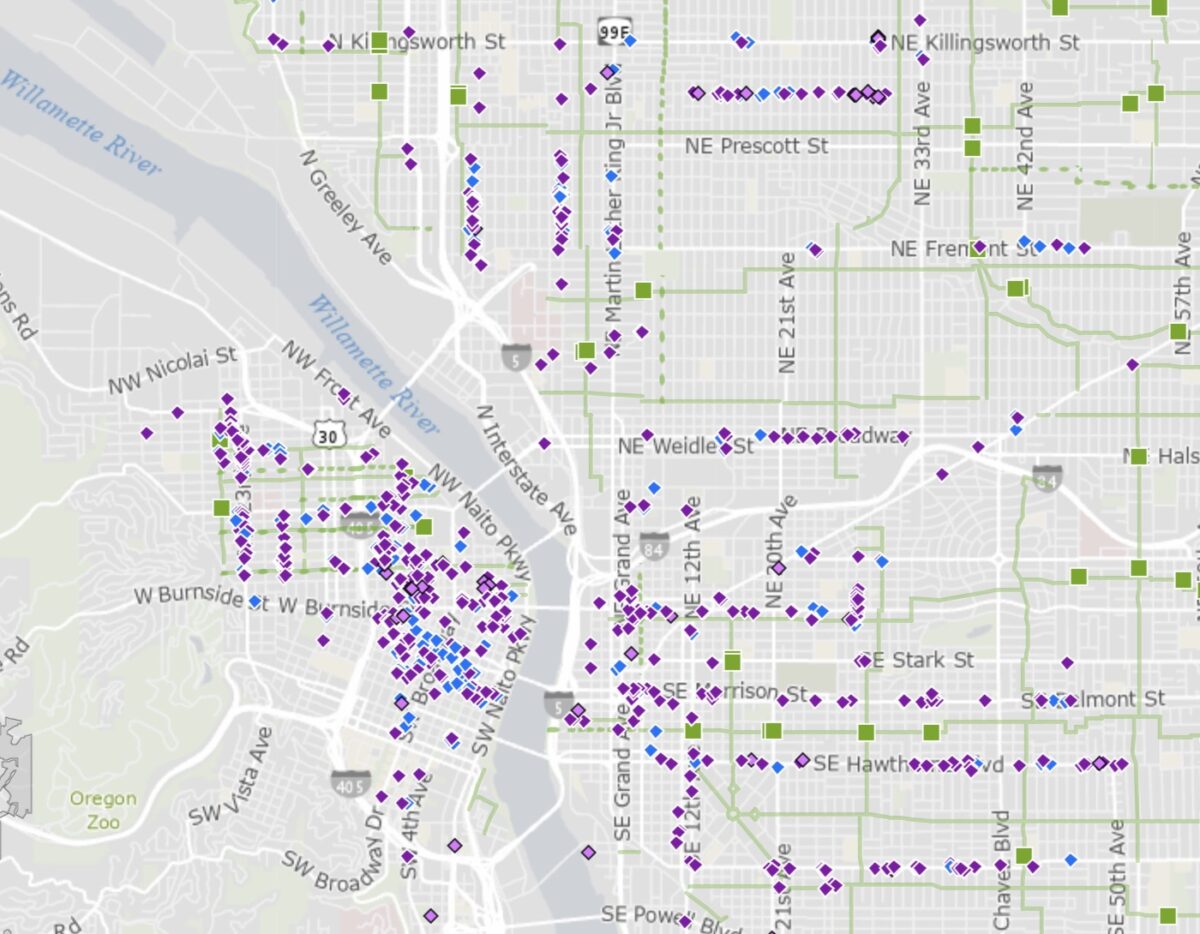
(Source: PBOT)
Nearly every commercial corridor in Portland (mostly west of 82nd) is now dotted with “street seats”, patios or some sort of carfree space. And they’re extremely popular, at least according to PBOT’s own survey data. Preliminary results of text-based surveys (promoted through pavement markings and signs at the plazas) with around 500 respondents reveal that 96% of people feel the spaces are “safe and vibrant” and 93% want them to stay in place. Another notable result of the survey is that 74% of respondents said they walked (63%) or biked (11%) to the plaza.
Advertisement
Falbo said those numbers prove there’s “explosive demand and interest” in carfree streets when PBOT makes them easy to create and accessible.
With proof of concept squarely in hand and more than a year of experience under their belt, PBOT seems eager to move into the next phase. The first phase was dictated by business owners, who were given mostly carte blanche to use the spaces however they deemed appropriate. This is why the plazas are not consistent in the way they look and feel. Some have obstructive tents and other elements that block through traffic. Some have no public seating, while others embrace passersby with trees, tables, pavement art, and other features.
At the Pedestrian Advisory Committee (PAC) meeting on October 19th, Falbo showed a slide titled, “Enhanced Plaza Upgrades” (below) that seemed to be a model of what we might expect for future plazas:
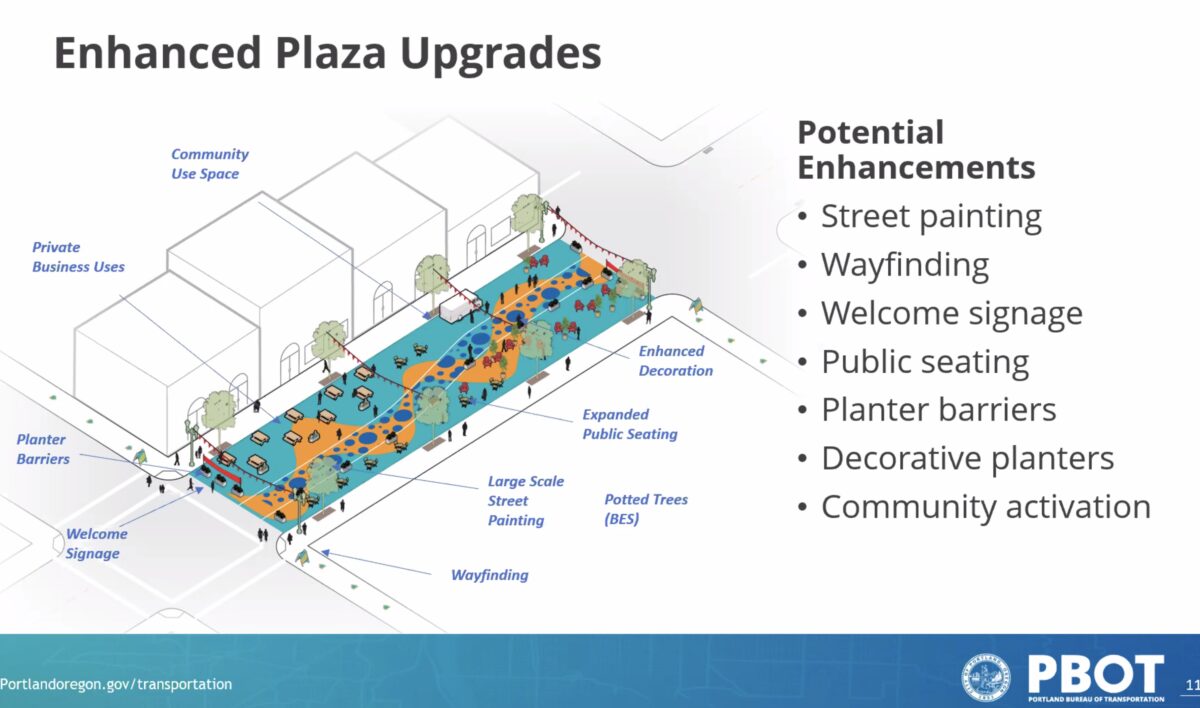
With funding in hand to beef up staff capacity and resources, the next phase will see PBOT play a much larger role. “There’s going to be work focused on active public space planning to formalize the role of these public spaces, as it relates to our transportation system plan [TSP],” Falbo said at the BBAC meeting.
“Our TSP has a lot of goals and policies about public space and street plazas, but it hasn’t really been operationalized in the same way that our bike plan or pedestrian plan has been, has so we’re excited to kind of integrate it into our planning frameworks to understand where they should be, how they support our town centers… how do we really turn this into something that can last?”
Falbo said the goal is to have PBOT building and managing the plaza spaces according to a more standardized plan, while still maintaining a strong partnership with the adjacent community.
Questions Over Who Pays, Who Benefits
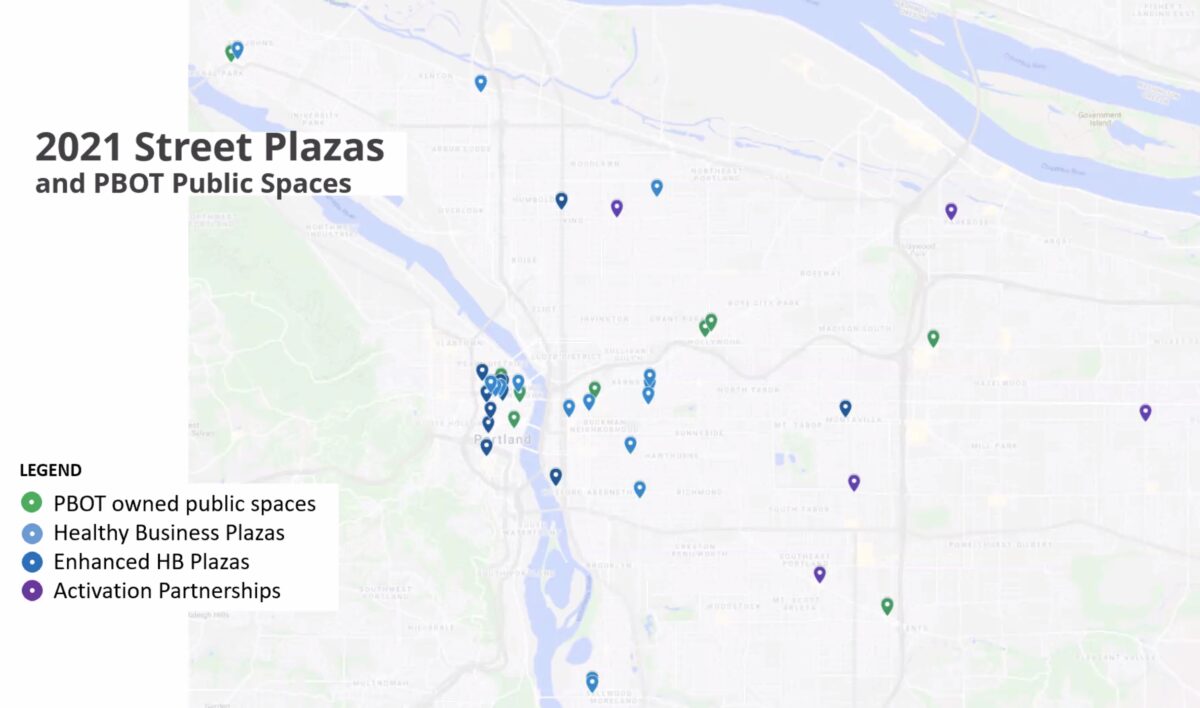
Asked by a PAC member about the dearth of plazas east of 82nd, Falbo said equity has been a key concern. “Ever since we opened up the original permitting program in 2020, where we were getting permit requests tends to align with a lot of historic development patterns.” Falbo said east Portland is a more challenging context because of the urban form that’s dominated by large arterial streets and private parking lots — the latter of which PBOT has no control over. But PBOT also had deep ties to east Portland community development groups and the new funding should help them find solutions.
Another looming issue is funding. A PBOT budget forecast estimates they’ll lose about $93 million in revenue due to the Covid pandemic — about half of that ($46.4 million) due to lost on-street parking revenue. Not only do these plazas and patios take up space that used to generate revenue for PBOT, but so far the entire Healthy Business permit program has been subsidized. “That will come due at some point,” Falbo said. PBOT says they only have funding for the plazas through July 2022.
In parking meter districts pre-Covid, PBOT charged businesses a fee to offset lost parking revenue if they wanted to use the curb zone for a different use.
For now, it’s an open question at PBOT as to how much they should charge a business for use of this valuable right-of-way. There’s an evaluation currently being done with economists to help them determine the right price. PBOT needs to be careful to balance the need for revenue with the popularity of the program. The momentum for carfree streets is worth much more to our city than the price of a permit.
If you have feedback to share about the future of plazas and parklets, email Falbo at nick.falbo@portlandoregon.gov or PBOT Safe Streets Initiative leader Scott Cohen at scott.cohen@portlandoregon.gov.

